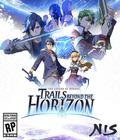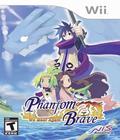Nippon Ichi has carved out a niche, and it isn't afraid to embrace it. Disgaea created a genre all its own, a strategy RPG based around dark humor, level-grinding, expansive inventory lists and absurdly complex methods of stat alteration. NIS games are not about simple percentages and strategic location, but about working your way to completion over hundreds of hours of tense grid-based battles.
However, somewhere in all those years since Disgaea's release, the Japanese developer lost its way. They dared to dream of a grid-less world of strategy, with level caps and a simpler, more manageable approach to equipment and inventories. Unfortunately for them, leaving well enough alone would have worked a heck of a lot more wonders than this bland adventure. Phantom Brave was a competent role-playing game with a weak story and bland characters when it was originally released on the PlayStation 2. On the Nintendo Wii, Phantom Brave: We Meet Again serves up only a spoonful of extra content and a heaping portion of the same.
The game is a port of the original game plus an additional mode that can be played right away, without any previous game data. Another Marona, the new game type, acts as a sort of parallel universe continuation of the original game's story. It asks players to start a new game with a new party, all at level one and without the benefits of money or experience. The main game, however, remains unchanged and still controls wonderfully with a classic controller, GameCube controller, or even the plain Wii Remote. It even includes the originally omitted New Game + mode, which lets you start over with stats and characters from a first play-through (or the Another Marona game type).
As Marona, the game's protagonist, you enter a world of grid-less strategy that still looks ripped from its younger brothers' coding. The sprites are huge and unmodified since the days of PS2, making a mockery of themselves on an HD-enabled display. The backgrounds and close-ups are all beautiful, crisp and sharp. The game is a showcase both of beautiful hand-drawn art and lazy, eye-numbing sprite work. Fortunately for gamers who happen to have the game, the developers seemed to realize how great their art design was and included an art disc in the box, letting you enjoy the game's style without getting bogged down in all that gameplay and story-telling nonsense.
That gameplay is familiar, but muddled. As Marona, you have the ability to "confine" phantoms. Since your party is all phantom all the time, this makes Marona your key to deployment. The lock she fits into can be any item on any battle map, ever. It's a cute gimmick, but not without its drawbacks. Your phantoms are summoned, taking the place of the item they're confined to, but only for short while, as each one gets only a set number of turns before it disappears for the rest of the battle. To make things even trickier, each type of item alters character stats in unique ways, adding or subtracting percentages to one of the key stats (Attack, Defense, Health, Intelligence, Resistance and Speed). Thanks to the unpredictability of items and placement, Marona is your only reliable character, and character selection becomes an organic process — as well as an enormous pain.
The other chronic pain is simple movement and attacking. Characters' movement ranges are outlined with a red circle, and attack ranges show up as blue-mesh suspended where the attacks are meant to land. In typical fashion, many attacks have bizarre radii and peculiar distances, but they're very difficult to judge and line up on the grid-less battlefields, especially factoring in verticality. This turns a 20-minute fight into a 30-minute battle. The time lost in poking and prodding around the map is unforgivable in a genre built on stats and the predictability they ensure. Not only do you have to eyeball your hit chance and potential damage, but you also have to scoot around characters two, three, four times to line up shots correctly or land in a spot out of harm's reach. The imprecision makes the game friendlier on a superficial level, but ugly and frustrating when played seriously and at higher levels. Characters pile up into an indistinguishable mess, enemies wander back and forth confusedly, and teammates even slide off the map and vanish for the rest of battle.
There are plenty of higher levels to aspire to. Random dungeons are readily available, and this time the gimmick pulling you in is "titles." Every character, item and dungeon has a title in front of their description, some unique, some hilarious and some genuinely useful. "Bl. Belt" boosts a fighter's hp, defense and attack considerably, "Erotic" impacts every stat marginally and "Failure" drops every stat enormously. When the titles are attached to dungeons, their stat boosts rise with every floor you complete, and once completed, you can put that title back on a character or item. The finagling can be fun, but like much of Phantom Brave's manipulations, it's either only slightly helpful or so clumsy that it becomes a chore to use.
The menus are unintuitive, and to even reach them, you have to wander around an item littered with your characters and their equipped items to talk to specific people with specific out-of-battle abilities. In order to change titles, you need to create a titlist, and to make dungeons, you need a Dungeon Monk. You need a healer to charge you money so you can recover health after battle, and you need a merchant to acquire battle-ready equipment. At the same time, you also can only have so many phantoms and items on your island, so saddling you with useless chumps is as cruel and pointless as the Another Marona story line.
The fusion system also suffers both from complications and clutter. You can fuse any items with any characters to try and gain abilities or boost stats. Stat-boosting only works for items, but both characters and items can boost their initial level caps through the fusion system, and their mana is always pooled. Mana is a mysterious reward, accrued from battles and randomly on the island, but it serves no purpose other than gaining skills. You can fuse to pool mana into one item or character, and then use that mana to learn abilities either directly from that item or by combining items, but it basically means that it's always good to stock up on items — or it would be, if it weren’t for the aforementioned cap on characters and items. Oh, well. This handicap leaves mana as just another obstacle to getting what you want in a timely fashion. The other handicaps include the simplistic equipment system using your weapon as your only source of abilities and in-battle stat alteration, and an SP system that requires you to use your SP every battle to gain more SP, in a never-ending cycle of wasted money and time.
Without the benefit of a tight or engrossing battle system, all that's left is the storytelling and presentation. Marona's story is a long one, spread across a world covered in islands and bringing in a colorful cast that still doesn't manage to show much distinct personality. Marona is overly cheery in a "let's all do our best" Pokémon sort of way, while Ash is a typical down-to-earth ghost. Well, OK, he's at least typically down-to-earth, balancing out the young girl's optimism and trust with a helpful dose of mistrust and protectiveness.
They hop from island to island as Chromas, this game's version of mercenaries, and they eventually get caught up in the fight to contain Sulphur, an ancient evil that's always looming in the back of people's minds. Their actions and dialogues are all impeccably voice-acted, but slow to progress and presented with the same dull sprites as the rest of the game. The music is also a great complement to the story, but none of the characters, from the protagonist duo to the cute monsters and Marona's crippled best friend, have traits that can't be found in a few dozen less time-consuming anime. In-game, they look and feel bland, and they even manage to have stock footage attack statements before battle just to round out the Sailor Moon package. The game's greatest accomplishment in the story is evoking sympathy for a little girl with dead parents and a curse.
The new mode does a little to work toward forgiveness. The menus are still incurably cluttered, the poor design choices (like asking you before every cut scene if you want to skip it) are still accounted for and the battle flow doesn't really change. Even the maps are mostly recycled, and the voice acting gets worse without the complete original cast, but the game plays more to its strengths and limits its scope a bit more. In this mode, you're still able to make a whole bunch of phantoms and buy weapons to equip them with, but you're restricted from dungeon-grinding for a while, and the cast of characters you start with are all solid and unique.
Each phantom has a strength and a weakness to work with, and the limited cash flow makes you a lot more cautious with your troops. You have to look carefully for every advantage you can get in battle, such as picking up weapons strewn around or confining phantoms into objects receiving "protection" while protecting the items sending them. None of this is technically new, but it's a lot more vital in Another Marona. Instead of making "protection" an incidental factor, it becomes the missing piece to the puzzle in many cases and makes you see why it was included in the first place. The story is just as weak, and the characters are possibly even more so, but the nice art with lazy sprites haven't changed, and the gameplay is just different enough to more readily catch interest.
It still doesn't make up for the many faults of this now-dated game. The lazy graphics, clumsy battle, awkward menus and stiff storytelling wage war against the cute and lovely design, music and the uncharacteristic simplicity of item management, but ultimately, the negatives come out on top, drowning out even its target audience. In trying to be more user-friendly, NIS created a beast that it's chosen to replicate again. Phantom Brave: We Meet Again is not the worst thing you could play, but in the world of strategy RPGs, it's trying hard to be. The disappointment of this game is something like seeing an A student turn in a C paper. It's not the worst thing in the classroom, but Nippon Ichi can do so much better. It's not really fair to subject the masses to this sub-par showing yet again.
Score: 6.5/10More articles about Phantom Brave: We Meet Again











 Phantom Brave improves upon the tactical gameplay found in Disgaea and La Pucelle in every way. Its redone, open-ended battle system is limited only by the user’s imagination, featuring 4 all new chapters, with a new character.
Phantom Brave improves upon the tactical gameplay found in Disgaea and La Pucelle in every way. Its redone, open-ended battle system is limited only by the user’s imagination, featuring 4 all new chapters, with a new character.







































